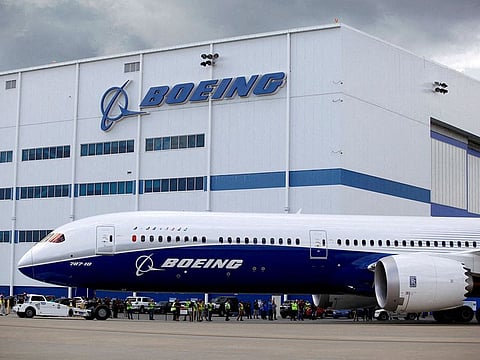Boeing's troubles keep mounting: From crashing 737 MAXs to now 787-8 Dreamliner
Troubled aircraft manufacturer's shares plunge nearly 8% after India plane crash

Dubai: Boeing, one of the world’s largest and most iconic aerospace manufacturers, has found itself in a continuous cycle of trouble over the past few years. Just when the company seemed to be turning the corner after several high-profile incidents, new challenges have emerged—casting doubt on its ability to recover.
The most recent setback occurred on Thursday, when an Air India Boeing 787-8 Dreamliner, Flight 171, crashed shortly after taking off from Ahmedabad. While the full details are still being investigated, the tragedy has once again stirred up concerns about Boeing’s long-standing issues with quality control and safety.
Also Read: Ahmedabad plane crash: What we know so far
Troubles with 737 MAX to 787 Dreamliner
Boeing’s problems didn’t start yesterday. In fact, its troubles have been years in the making, beginning with the grounding of its 737 MAX aircraft after two fatal crashes in 2018 and 2019. Lion Air Flight 610 and Ethiopian Airlines Flight 302 both involved the 737 MAX, leading to a worldwide grounding that lasted almost two years. It was a historic blow to Boeing, one that severely damaged its reputation and financial standing.
Fast forward to 2024, and there was another incident involving the 737 MAX. Alaska Airlines’ Boeing 737 MAX 9 suffered an in-flight door plug loss, reminding the aviation world that Boeing’s issues with quality control are still not entirely resolved.
But the company’s problems don’t stop there. The Boeing 787 Dreamliner, which was meant to be the future of long-haul travel, has faced its own challenges. From battery fires that led to groundings in 2013 to the more recent quality control issues, Boeing has struggled to get its flagship model right. In 2021, whistleblowers within the company revealed that there were excessive gaps between fuselage panels, violating FAA-approved limits. This led Boeing to halt deliveries of the 787 Dreamliner for a time and forced the company to rework planes already in service.
Why Boeing’s problems keep mounting
Boeing’s struggles go beyond just a few bad headlines. They have a profound impact on the company’s bottom line and its standing in the global aviation industry.
1. Quality control issues:
One of Boeing’s biggest issues has been quality control. Manufacturing defects in parts and issues with sealants have plagued several of its aircraft programs. The company has faced significant scrutiny from regulators, particularly over the 737 MAX and 787 programs. These problems have raised serious questions about the safety of Boeing’s planes.
2. Rushed production:
Under immense pressure to meet production targets, Boeing has reportedly compromised safety. The company’s strategy to ramp up aircraft production quickly in response to strong demand has led to production flaws, both on the 737 and 787 lines. This rushed approach has undermined quality assurance, leaving Boeing exposed to defects that could have been avoided with more careful oversight.
3. Safety concerns:
Safety is, of course, the paramount concern for any aviation manufacturer. The crashes of the 737 MAX were a tragic reminder that poor design and oversight can have deadly consequences. Boeing’s record of safety lapses has not only led to crashes but has also raised the stakes for every aircraft it produces. The company continues to deal with the fallout from these incidents.
4. Whistleblower revelations:
In 2021, Boeing engineers and whistleblowers revealed disturbing details about the company’s internal culture. There were allegations of a “cover-up” surrounding safety issues, with some saying that workers feared retaliation if they raised concerns. The death of several whistleblowers further tarnished Boeing’s image and exposed deep-rooted cultural problems that have undermined its ability to improve.
5. Corporate culture:
The whistleblower issues point to a larger problem: Boeing’s corporate culture. A disconnect between senior management and workers has led to a culture of fear, where employees are reluctant to speak up about safety concerns. This, combined with a lack of transparency and accountability, has significantly hampered Boeing’s ability to recover from its past mistakes.
Financial toll, future uncertainty
Boeing's financial performance has taken a major hit due to these ongoing issues. In 2024, the company posted an $11.8 billion net loss, marking its second-largest financial loss in history. The combination of production delays, FAA restrictions, and labor disputes weighed heavily on its ability to generate profits.
Despite efforts to stabilize, Boeing still faces significant challenges. In Q4 2024, the company raised $24 billion in capital, increasing its cash reserves to $26.3 billion. However, with rising debt levels (now $53.9 billion) and continued cash outflows, Boeing faces another year of negative free cash flow in 2025.
Despite these struggles, Boeing has made strides in stabilizing its operations. The company’s CEO, Dave Calhoun, has announced plans to step down, signaling a potential shift in leadership and strategy. Boeing has pledged to make sweeping changes, focusing on improving quality control, restoring safety, and rebuilding trust with regulators, customers, and the public.
Looking ahead: Will Boeing recover?
Boeing’s future remains uncertain. While the company is working to address its issues, its recovery will be a long and difficult journey. The aviation world is watching closely, with many waiting to see if Boeing can regain its former status as a global leader in aerospace.
For now, the company’s troubles continue to pile up, with no clear end in sight. Will Boeing rise above its challenges, or will its history of problems continue to hold it back? Only time will tell.
Sign up for the Daily Briefing
Get the latest news and updates straight to your inbox



